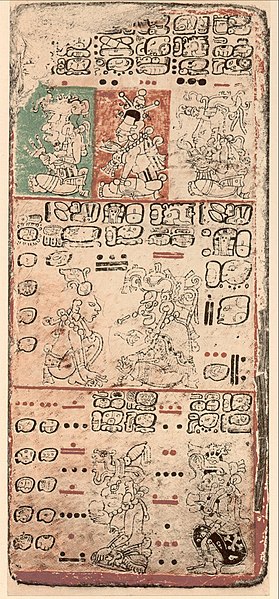The traditions of indigenous Mesoamerican literature extend back to the oldest-attested forms of early writing in the Mesoamerican region, which date from around the mid-1st millennium BCE. Many of the pre-Columbian cultures of Mesoamerica are known to have been literate societies, who produced a number of Mesoamerican writing systems of varying degrees of complexity and completeness. Mesoamerican writing systems arose independently from other writing systems in the world, and their development represents one of the very few such origins in the history of writing.
A monumental inscription in Maya hieroglyphics from the site of Naranjo, relating to the reign of king Itzamnaaj K'awil
A page of the Precolumbian Mayan Dresden Codex
Founding of Tenochtitlan, Codex Mendoza
Conquistador Nuño Beltrán de Guzmán as depicted in the annal Codex Telleriano Remensis
Mesoamerican writing systems
Mesoamerica, along with Mesopotamia and China, is one of three known places in the world where writing is thought to have developed independently. Mesoamerican scripts deciphered to date are a combination of logographic and syllabic systems. They are often called hieroglyphs due to the iconic shapes of many of the glyphs, a pattern superficially similar to Egyptian hieroglyphs. Fifteen distinct writing systems have been identified in pre-Columbian Mesoamerica, many from a single inscription. The limits of archaeological dating methods make it difficult to establish which was the earliest and hence the progenitor from which the others developed. The best documented and deciphered Mesoamerican writing system, and the most widely known, is the classic Maya script. Earlier scripts with poorer and varying levels of decipherment include the Olmec hieroglyphs, the Zapotec script, and the Isthmian script, all of which date back to the 1st millennium BC. An extensive Mesoamerican literature has been conserved, partly in indigenous scripts and partly in postconquest transcriptions in the Latin script.

Monument 3 at San José Mogote. The two shaded glyphs between his legs are likely his name, Earthquake 1.
Detail showing glyphs from 2nd century CE La Mojarra Stela 1. The left column gives a Long Count date of 8.5.16.9.9, or 162 CE. The other columns are glyphs from the Epi-Olmec script.
Stela 5 from Abaj Takalik
Maya glyphs in stucco at the Museo de sitio in Palenque, Mexico








